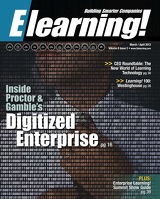Elearning! Magazine: Building Smarter Companies via Learning & Workplace Technologies.
Page 20 of 52
digitalrevolution
capabilities that many retailers don't have, so often we can use the data to help them decide how to merchandise or market their business in a positive way. It would be heretical in this company to
say that data are more valuable than a brand, but it's the data sources that help create the brand and keep it dynamic. So those data sources are incredibly impor- tant. Therefore, we go to the extreme to protect whatever consumer data we get. It's a board-level enterprise risk-management issue for us. We have very clear firewalls between one retailer and another and strict policies — for example, about how long a "cooling off " period you need to have when working on projects with dif- ferent retailers. All of this comes with our strategy of being the most digitally enabled company in the world. We can't do that without being an industry leader on data security and privacy.
THE DIGITAL WORKFORCE McDonald: When I started with P&G;, in 1980, almost nothing was digital. Back then, our Management Systems Division — as we called it then — had mainframe computers, but our people did more work on phone systems than on comput- ers. And whenever I would get together
'When you've actually done a
simulation, you truly realize the importance of data.'
with them, I would ask, "How many of you have coded BCD?" or, "Have you ever done a Monte Carlo simulation?" Nobody would raise a hand. They didn't have those kinds of skills. More than two decades later, as vice
chairman of global operations, I and my colleague Filippo Passerini, who today is the CIO of P&G;, began to put together some very clear strategies to hire people with different skills. We needed people with backgrounds in computer modeling and simulation. We wanted to find people who had true mastery in computer science, from the basics of coding to advanced program- ing. When you've actually done a simula- tion, you truly realize the importance of the data; it's classic "garbage in, garbage out." We've come a long way toward meeting our
goals today, but we still have further to go. For example, we established a baseline digital- skills inventory that's tailored to every level of advancement in the organization. We have a training facility to make sure that if you're in a particular area, you're competent on the sys- tems for that area. This goes for senior man- agers too; we have an area in the facility where we can pull the curtains, so to speak, and work with senior managers privately so we don't embarrass anyone. But we've got to have the standards for everyone because otherwise we'll dumb the organization down to the low- est common denominator. Ultimately, though, P&G; has been pretty
good about hiring for analytical thinking. We hire very good people and then train them. I remember the day I joined the com- pany and one of the managers a few levels up said, "Throw away your MBA textbooks and we'll teach you; we'll give you another MBA." And I think that's still practical and relevant today. Nonetheless, analytical-think- ing skills have become even more important to this company. We need to come up with the ideas to innovate, and those innovations are always informed by data.
—Michael Chui is a senior fellow of the McKinsey Global Institute and is based in McKinsey's San Francisco office; Tom Fleming is a member of McKinsey Publishing and is based in the Chicago office. This arti- cle was originally published in McKinsey Quarterly, www.mckinseyquarterly.com. Copyright (c) 2011 McKinsey & Company. All rights reserved. Reprinted by permission.
20 March / April 2012 Elearning!
